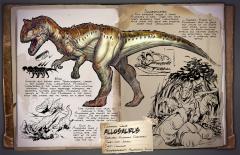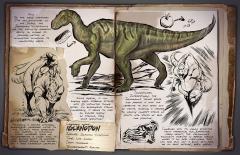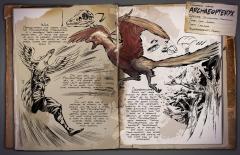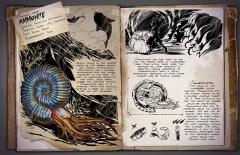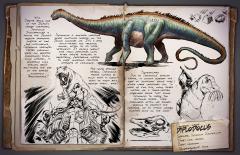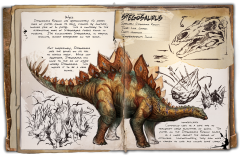Search the Community
Showing results for tags 'late jurassic'.
-
From the album: Dossiers
Common name: Allosaurus Species: Allosaurus Therotribus Time: Late Jurassic Diet: Carnivore Temperament: Aggressively Social Wild: Smaller but faster than tyrannosaurus, larger but slower than Carnotaurus, Allosaurus Therotribus is the island's resident pack-hunting theropod. While most aggressive theropods are relatively solitary creatures, Allosaurus lives in groups of 3-4. One Allosaurus is the alpha, while the others are its mates or a beta male. Like humans find value in forming a tribe, the Allosaurus has evolved to hunt in packs. Its saw-shaped teeth leave its prey bleeding and maimed, making escape difficult. Once an Allosaurus slows a creature with its cutting bite, the rest of its pack quickly close in for the kill. Domesticated: Not everyone thinks a tamed Allosaurus is ideal. Those who value speed generally tame Carnotaurus, while those who value raw stopping power tame Tyrannosaurus. However, Riders of Allosaurus tend to value the utility of its Alpha pack status, which along with its bleed-inducing attacks and relative mobility, can effectively turn the tide of a combined arms battle.- 1 comment
-
- allosaurus
- rideable
- (and 8 more)
-
From the album: Dossiers
Common Name: Iguanodon Species: Iguanodon vicissitudinis Time: Late Jurassic Diet: Herbivore Temperament: Reactive Wild: Of the many creatures I've yet encountered the island, the Iguanodon vicissitudinis has the distinctly versatile ability to change its primary method of locomotion according to its momentary needs. While bipedal, it can employ rapid stabbing attacks with its distinctive thumb spikes. In quadrupedal stance, conversely, it seems to have an endless supply of stamina, even while sprinting! Primarily a rather lethargic quadrupedal herbivore native to the island's many grasslands and forests, in situations where increased speed or maneuverability is called for, it will quickly shift its posture into bipedal stance and behave like a very different creature! Domesticated: Interestingly, the Iguanodon's thumb spikes also provide it with the capability to pick seeds out of fruits, allowing a farmer to handily convert stacks of fruits into stacks of seed for planting. Combined with its highly effective fruit harvesting and substantial carry weight, the Iguanodon's excellent mobility in bipedal stance makes it an ideal field-hand that can also pull off a quick get-away, or an agile defense, when needed. -
From the album: Dossiers
Common Name: Archaeopteryx Species: Archaeopteryx Magnamilvum Time: Late Jurassic Diet: Carnivore Temperament: Fearful Wild: Approximately one meter long, the Archaeopteryx Magnamilvum is a primarily tree-dwelling proto-bird. It avoids the ground as much as possible, preferring to stay in the safety of the trees, where few predators can reach it. I’ve not seen an Archaeopteryx outright fly yet, so it’s possible that they can’t generate enough lift to do more than glide long distances between perches. I’m not sure how a creature as fearful of the ground can be such a picky eater, but Archaeopteryx only seems to consume certain rare insect matter. The most likely explanation is that it tends to nest in infested trees, stripping them bare of such food sources. Domesticated: While not large enough to bare the full weight of an adult human, Archaeopteryx still has great utility. Despite the creature’s inability to fly, its wings have sufficient strength to dramatically slow the rate of a person’s descent if that person holds Archaeopteryx while airborne. Taming Archaeopteryx can be somewhat troublesome, though, as it refuses to eat most common food sources, and glides to prospective safety at the first sign of any interloper.-
- archaeopteryx
- fearful
-
(and 4 more)
Tagged with:
-
From the album: Dossiers
Common Name: Ammonite Species: Ammonitina Multiamicus Time: Late Jurassic - Mid Cretaceous Diet: Bottom Feeder Temperament: Passive Wild: Usually found in the deepest parts of the waters around the island, Ammonitina Multiamicus has a strange relationship with the other creatures of the deep. It must do something beneficial for them, since every nearby sea creature defends Ammonitina when it is attacked. What this distinct symbiosis is based on, alas, I have not yet discovered. Ammonitina has also made its way into the deeper parts of underwater caves. Even within these caves, the creature will draw attention if assaulted, making harvesting its resource-rich shell a tricky proposition depending on what other dangers may be lurking nearby. Domesticated: Like many of the untamable ocean dwellers, Ammonitina still has enough utility to be a valuable hunting target. If a tribe is willing to risk the wrath of nearby would-be protectors, Ammonitina bile can be harvested from it’s corpse’s innards. This bile can be worked over with other chemicals to make many powerful concoctions, usually antidotes against the most powerful poisons and illnesses. Its shell meanwhile, is rich in rare materials, presumably due to the creature’s unique place along the Island’s food chain.-
- ammonite
- late jurassic
- (and 6 more)
-
From the album: Dossiers
Common Name: Diplodocus Species: Diplodocus Insulaprincep Time: Late Jurassic Diet: Herbivore Temperament: Naive Wild: Despite being one of the Island's larger creatures, Diplodocus Insulaprincep is among the Island's smaller sauropods. Instead of the size and intelligence, Diplodocus developed faster maximum speed and greater endurance. When fully matured, it generally only reaches about two-thirds the size of the rather enormous Brontosaurus. Diplodocus is another creature whose continued survival on the Island confuses me. It's a very thick-headed and trusting animal, often to its fatal detriment. It usually doesn't flee from predators until after they've attacked it repeatedly, preferring instead to make numerous fruitless attempts at friendship. For some strange reason, Diplodocus trusts humans so much that it doesn't seem to fight back against them... ever! Domesticated: Due to Diplodocus' smaller frame, it cannot support the type of 'platform' saddle that other large creatures can. To make up for this, many tribes instead use a three-seater passenger saddle that allows Diplodocus to carry two additional riders. These passengers often use ranged weapons to protect the creature, or to attack nearby enemies while on the move!-
- diplodocus
- dinosaur
-
(and 7 more)
Tagged with:
-
From the album: Dossiers
Common Name: Stegosaurus Species: Stegosaurus regium Time: Late Jurassic Diet: Herbivore Temperament: Docile Wild: Stegosaurus regium has approximately 16 paired rows of plates along its back, flanked by another smaller pair of 6 plates. This is contrary to the alternating rows of Stegosaurus fossils found in museums. I've encountered Stegosaurus, in varying amounts almost everywhere on the island. Not surprisingly, Stegosaurus uses the spines on its tail to defend itself. While not aggressive, Stegosaurus will come to the aid of other nearby Stegosaurus. This implies it to be a herd animal. Domesticated: Commonly used as a safe way to transport large quantities of goods. The plates on the Stegosaurus regium double as a cover against the arrows of the attackers. Unfortunately, they also make it harder to load and unload some cargo. The Stegosaurus attacks by swinging its spiked tail at the opponent, which has a wide area of attack. Care must be taken not to anger any nearby dinosaurs by accidentally hitting them. The swinging attack, however, is excellent for collecting large amounts of berries.-
- berry harvesting
- late jurassic
-
(and 6 more)
Tagged with:
